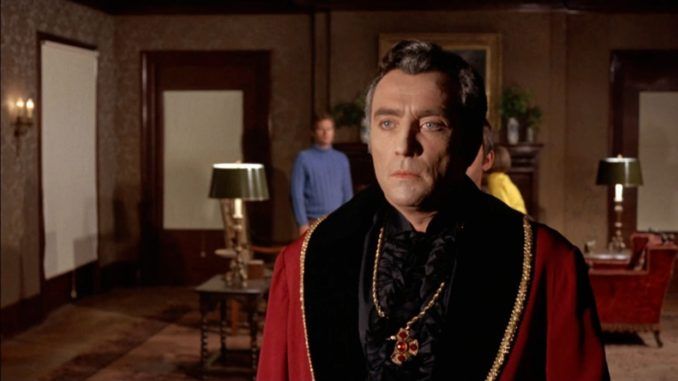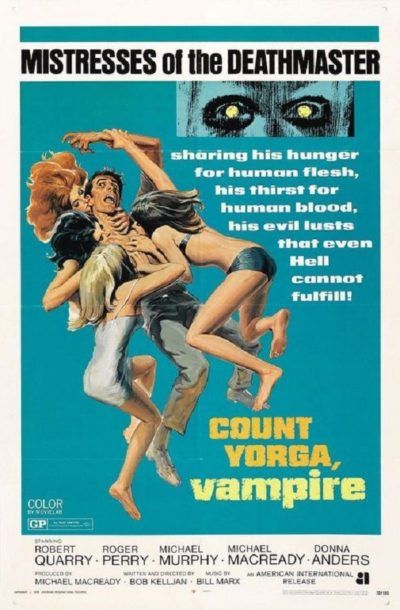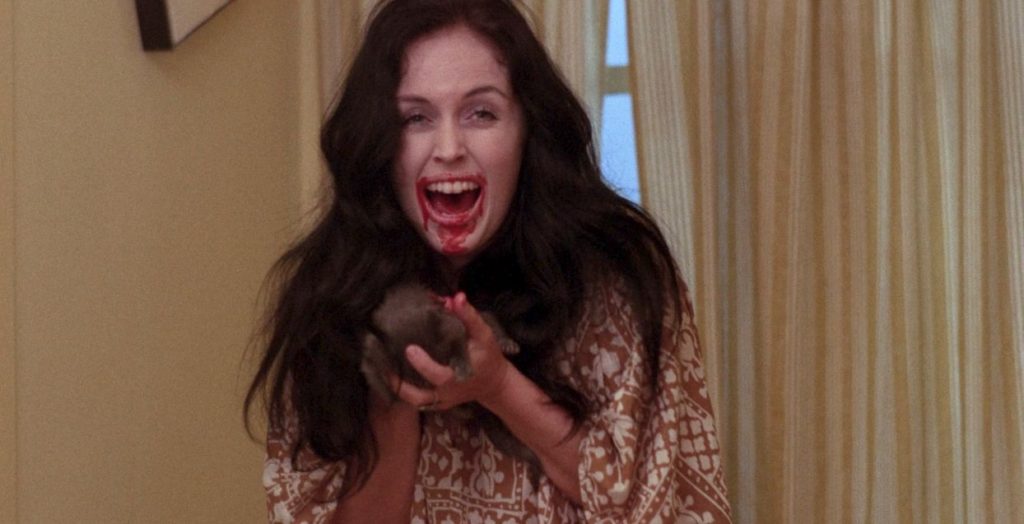
Rating: C+
Dir: Bob Kelljan
Star: Robert Quarry, Michael Macready, Roger Perry, Donna Anders
I had a brief moment of confusion when the title came up as The Loves of Count Iorga, with an I. Apparently, it was originally intended to be a soft-core porn film by that name. But after reading the script, Quarry talked to the producers. “I said why don’t you just make a regular horror film out of it? They said will you do it? Of course I said yes, if it’s going to be a straight horror film.” But the producers hedged their bets. Quarry notes, “They left places where they could add whatever was necessary — two more breasts, or whatever,” in case they needed to pivot back to sex for sales purposes. Then, after AIP bought it, Samuel Z. Arkoff changed the Count’s name to make it easier for ticket buyers to pronounce. Apparently, word of the change failed to reach some prints.
The movie opens with the arrival of a coffin at the Port of Los Angeles, which is then taken to the mansion of its owner, Count Yorga (Quarry). He seems to have settled into Californian society quite well – albeit only the after dark kind. For the next time we see him, he’s running a seance for a group of young people, in particular, Donna (Anders), who wants to communicate with the spirit of her late mother. However, the Count regards the party as more of a buffet, and with a combination of hypnosis and blood-sucking, begins to turn the ladies into vampire brides. Their boyfriends Mike (Macready) and Paul, along with friend Dr. Jim Hayes (Perry), get no help from the sceptical authorities, and so have to defeat the vampire themselves if they are to save the women’s souls. The women, naturally, don’t get any say in the matter. It was the seventies, after all.
 Much of this feels like a knock-off version of the second half of Dracula, omitting the part where Jonathan Harker goes to the Count’s castle, and beginning with Dracula’s arrival in Whitby. [Los Angeles = Whitby, obviously..] However, names and details have been changed, perhaps as in Nosferatu, in an attempt to prevent legal action. I’m not sure why they bothered, since Bram Stoker’s novel was in the public domain in the US by this point (though as an aside, the occasional claim Stoker never applied for a copyright on the book, appears to be erroneous). Regardless of the cause, the vampire nobleman is relocated here from Transylvania to Bulgaria, and renamed, of course. It teeters on the edge of using the “I never drink… wine” line at the seance, instead Yorga going with, “Perhaps I’ll have a little snack later on…”
Much of this feels like a knock-off version of the second half of Dracula, omitting the part where Jonathan Harker goes to the Count’s castle, and beginning with Dracula’s arrival in Whitby. [Los Angeles = Whitby, obviously..] However, names and details have been changed, perhaps as in Nosferatu, in an attempt to prevent legal action. I’m not sure why they bothered, since Bram Stoker’s novel was in the public domain in the US by this point (though as an aside, the occasional claim Stoker never applied for a copyright on the book, appears to be erroneous). Regardless of the cause, the vampire nobleman is relocated here from Transylvania to Bulgaria, and renamed, of course. It teeters on the edge of using the “I never drink… wine” line at the seance, instead Yorga going with, “Perhaps I’ll have a little snack later on…”
He does deliver the immortal quote, “I believe I brought a cape,” which you would think, should have been a red flag for all concerned, right there. Who else except a vampire would wear a cape in Los Angeles during the seventies? There’s also a Renfield-alike in the picture, a mute servant called Brudah – it took me a while to not hear “Buddah” – who appears imbued with supernatural strength. Otherwise, Yorga is a very straightforward vampire: crosses, stakes and daylight all work against him, in exactly the way you would expect. These are laid out in an effective and sonorous voice-over at the beginning, provided by George Macready, Michael’s father. I’m going to assume the family connection extends to Erica Macready, who appears as Dr. Hayes’s French nurse, Babette.
Quarry makes for an okay vampire, one who barely tries to hide his nature. He probably doesn’t need to: when Dr. Hayes tries to alert the authorities, more than once, he is written off as just another in a long series of kooks. It’s a small but effective way of bypassing the usual question of, “Why don’t the authorities get involved?” The most memorable and disturbing moment, however, is likely when Paul and Michael check in on Erica, one of Yorga’s women, after a concerning phone-call, only to find her chowing down on her pet kitten (below). If only they’d got there sooner. Mind you, it’s hard to take heroes seriously when their vehicle of choice is a Volkswagen Bus. “0-60 in eleven minutes,” according to Chris. They’d likely have been quicker walking to Erica’s apartment.
 Outside of the setting, it’s all rather pedestrian in comparison to Hammer’s output, and there’s probably not enough charisma on either side of the playing field to make it memorable. I did like the ending though, which does deviate from Hammer’s inevitable “good shall prevail over evil” conclusions, and takes a considerably darker turn. Not least, that dispatching the vampire does not revert those whom he has turned. Getting to this point (pun not intended), does require some rather underwhelming kills, some of which involve less the staking of vampires, and more them moving accidentally onto the weapon. “That was stupid,” was Chris’s conclusion at the end. It appears this cinematic treat did not stand the test of time, several decades having passed since she last saw it. I wouldn’t quite go that far, personally.
Outside of the setting, it’s all rather pedestrian in comparison to Hammer’s output, and there’s probably not enough charisma on either side of the playing field to make it memorable. I did like the ending though, which does deviate from Hammer’s inevitable “good shall prevail over evil” conclusions, and takes a considerably darker turn. Not least, that dispatching the vampire does not revert those whom he has turned. Getting to this point (pun not intended), does require some rather underwhelming kills, some of which involve less the staking of vampires, and more them moving accidentally onto the weapon. “That was stupid,” was Chris’s conclusion at the end. It appears this cinematic treat did not stand the test of time, several decades having passed since she last saw it. I wouldn’t quite go that far, personally.
I felt, for a cheap effort, it’s reasonable enough and the low-rent approach gives it a certain down-to-earth nature that works well with the contemporary setting. The film cost less than $100,000 to make, but grossed $160,000 in its first week alone, making it perhaps the earliest successful attempts to drop a vampire into the modern era. I suspect the profits reaped by AIP from Yorga may have inspires Hammer’s attempts to bring Dracula into the modern day, such as Dracula A.D. 1972 – albeit with more mixed success. The unexpected hit, naturally, led to a sequel the following year, The Return of Count Yorga, though plans for a third entry were dropped. Similarly scrapped was an idea to have Yorga cross over into the Dr. Phibes franchise. Instead, Quarry did appear as antagonist Darius Biederbeck in Dr. Phibes Rises Again.
This review is part of our October 2023 feature, 31 Days of Vampires.
